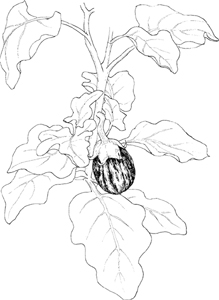
BOTANICAL NAME: Solanum melongena
FAMILY: Solanaceae

There are three words for eggplant in ancient Sanskrit: vatingana, vartaka, and vrntaka. All three of them are now thought to be of Munda origin, the language spoken by very ancient aboriginal peoples who once inhabited the whole of India. This linguistic evidence alone proves that the eggplant has been under cultivation on the Indian subcontinent for many thousands of years. Today the eggplant is commonly called brinjal in India and is an important feature of the cookery.
The English first saw the white egg-shaped brinjal in the 1500s, when seed for this plant was being distributed among European botanists. Evidently, this shape and color suggested the name eggplant, which we use today, but India also has many other varieties of the same size and shape. There is a common one that is green; others are purple, black, or striped.
Udmalbet (pronounced OOD-mal-bet) is a “folk” variety from southern India which seems to blend the best culinary qualities of its more monochromatic cousins. Udmalbet (its dialect name means “darkly striped”) is ripe when it is green, but the green skin is richly streaked with deep violet purple. This strikes a handsome contrast to the plant itself, which has pale gray leaves. Added to this are the large, soft rose flowers, which bloom in succession over the summer, and the ripe fruit, which turns bright yellow. For ornamental qualities alone, this baby eggplant is a visual delight. It is also excellent in cooking.
It is so tender that the skin can be eaten. It is not bitter, so it does not require the usual sprinkling of salt to take off bitterness before it is cooked. Sliced, diced, chopped, shredded, ground, it is used in innumerable Indian curries and chutneys. This is because vegetables like eggplant meet the ritual requirements of strict orthodox Hindus for foods prepared in temples or for marriages and other important events. Udmalbet is employed almost exclusively in this type of culinary context.
One of my favorite eggplant chutneys using Udmalbet comes from Mysore in the vicinity of Madras. The eggplants are baked, mashed, and set aside. Grated coconut is then fried with red peppers, cumin, tamarind, mustard, urad dal, asafetida, and garlic until it turns red. Green peppers, onions, and fresh ginger ground to a paste are then added along with the reserved mashed eggplant. This is all ground together to make a smooth puree, which is heated until it thickens. It is completely vegetarian and may be eaten as a condiment on fried plantains, sweet potatoes, or large slices of fried eggplant. As though the beauty of its taste were not enough, nature has endowed Udmalbet with a handsome gray plant that provides a startling accent to the garden when laden with a bounty of colorful fruits.